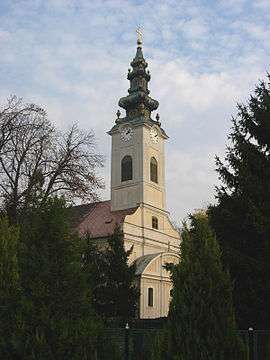Greek Catholic Apostolic Exarchate of Serbia
| Greek Catholic Apostolic Exarchate of Serbia Гркокатолички апостолски егзархат у Србији | |
|---|---|
 Greek Catholic Cathedral of Saint Nicholas in Ruski Krstur, Serbia | |
| Location | |
| Country | Serbia |
| Territory | Serbia |
| Metropolitan | exempt, directly subjected to the Holy See |
| Statistics | |
| Population - Catholics |
22,085 (2013) |
| Parishes | 21 (2013) |
| Information | |
| Denomination | Greek Catholic Church of Croatia and Serbia |
| Rite | Byzantine Rite |
| Established | (2003) 2013 |
| Cathedral | Greek Catholic Cathedral of St. Nicholas in Ruski Krstur, Serbia |
| Secular priests | 20 (2013) |
| Current leadership | |
| Pope | Francis |
| Bishop | Đura Džudžar |
| Metropolitan Archbishop | exempt, directly subjected to the Holy See |
The Greek Catholic Apostolic Exarchate of Serbia (Serbian: Гркокатолички апостолски егзархат у Србији) is an ecclesiastical jurisdiction of the Catholic Church for Eastern Catholics of the Byzantine Rite in Serbia. It was founded in 2003 as the "Greek Catholic Apostolic Exarchate of Serbia and Montenegro" and reduced to the territory of Serbia in 2013. Since 2003, head of the Exarchate is bishop Đura Džudžar.[1]
The Exarchate is part of the Greek Catholic Church of Croatia and Serbia, together with the Greek Catholic Eparchy of Križevci in Croatia. In terms if jurisdiction, the Exarchate it is exempt and directly subjected to the Holy See.[2] There are no ecclesiastical provinces for it to belong to in the Greek Catholic Church of Croatia and Serbia, which lacks a Metropolitan of its own, since the Eparchy of Križevci (the only other jurisdiction in the Greek Catholic Church of Croatia and Serbia) is suffragan to the Roman Catholic Archdiocese of Zagreb.[3]
Greek Catholic Apostolic Exarchate of Serbia and Montenegro (2003–2013)

Until 2001, the Greek Catholic Eparchy of Križevci had full jurisdiction over all Eastern Catholics of the Byzantine Rite throughout the entire territory of the former Yugoslavia, including all of its successor states: Croatia, Slovenia, Bosnia-Herzegovina, Serbia, Montenegro and Macedonia.
After the formation of independent successor states from what had been Yugoslavia, the process of administrative reorganization was initiated. In 2001, a separate Byzantine Catholic Apostolic Exarchate of Macedonia was formed for Eastern Catholics of the Byzantine Rite in neighboring Macedonia. It was fully separated from the Eparchy of Križevci and directly subjected to the Holy See.[4]
In 2003, a new Apostolic Exarchate was created for Roman Catholics of the Byzantine Rite in Serbia and Montenegro, the Greek Catholic Apostolic Exarchate of Serbia and Montenegro. Its first and only exarch was bishop Đura Džudžar, who was appointed on August 28 (2003), with residence in Ruski Krstur.[1] This exarchate remained in association with the Eparchy of Križevci.
In 2004, the Greek Catholic Apostolic Exarchate for Serbia and Montenegro had 26 parishes with 22,934 faithful and 18 priests, and in 2009 it had 21 parishes with 22,369 faithful and 18 priests.[5]
Greek Catholic Apostolic Exarchate of Serbia (2013–present)
On 19 January 2013, all Eastern Catholics of the Byzantine Rite in Montenegro were entrusted to the local Latin Bishops, so the jurisdiction of the Greek Catholic Apostolic Exarchate of Serbia and Montenegro was reduced to just Serbia.[6] Bishop Đura Džudžar remained in his post as exarch. The Greek Catholic Apostolic Exarchate of Serbia is still associated with the Greek Catholic Eparchy of Križevci as part of the Greek Catholic Church of Croatia and Serbia.
The Greek Catholic Apostolic Exarchate of Serbia practices liturgy in the Slavonic form of Byzantine Rite and uses the Old Church Slavonic language and the Cyrillic alphabet. Adherents of the Eastern Catholic Byzantine Rite in Serbia are mainly ethnic Rusyns, Ukrainians, and Rumanians. In 2013, the Greek Catholic Apostolic Exarchate for Serbia had 21 parishes with 22,085 faithful and 20 priests.[7]
See also
- Byzantine Catholic Church in Montenegro
- Eastern Catholic Churches
- Greek Catholic Church of Croatia and Serbia
- Greek Catholic Eparchy of Križevci
- Roman Catholicism in Serbia
- Religion in Serbia
- Religion in Vojvodina
- Religion in Kosovo
References
- 1 2 Catholic Hierarchy: Bishop Đura Džudžar
- ↑ Catholic Hierarchy: Byzantine Catholic Apostolic Exarchate of Serbia
- ↑ Catholic Hierarchy: Byzantine Catholic Eparchy of Križevci
- ↑ "Archived copy" (PDF). Archived from the original (PDF) on April 30, 2016. Retrieved 2016-06-06., AAS 93 (2001), p. 339.
- ↑ Catholic Hierarchy: Byzantine Catholic Apostolic Exarchate of Serbia and Montenegro
- ↑ Acta Apostolicae Sedis, 105 (2013), p. 187.
- ↑ Catholic Hierarchy: Byzantine Catholic Apostolic Exarchate of Serbia
External links
| Wikimedia Commons has media related to Apostolic Exarchate of Serbia. |
- Eparchy of Križevci (in Croatian)
- Byzantine Chatolic Eparchy of Križevci on Catholic Hierarchy
- Apostolic Exarchate of Macedonia (2001-) on Catholic Hierarchy
- Apostolic Exarchate of Serbia and Montenegro (2003-2013) on Catholic Hierarchy
- Apostolic Exarchate of Serbia (2013-) on Catholic Hierarchy
- Bishop Đura Džudžar on Catholic Hierarchy
- Article on Greek Catholics in Former Yugoslavia by Ronald Roberson on the CNEWA web site
- Catholic Information

